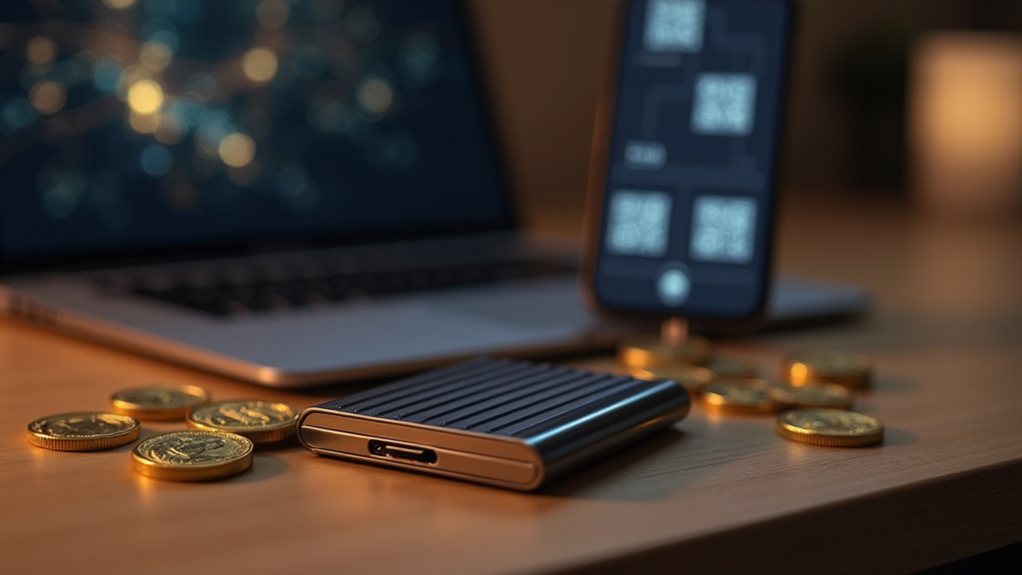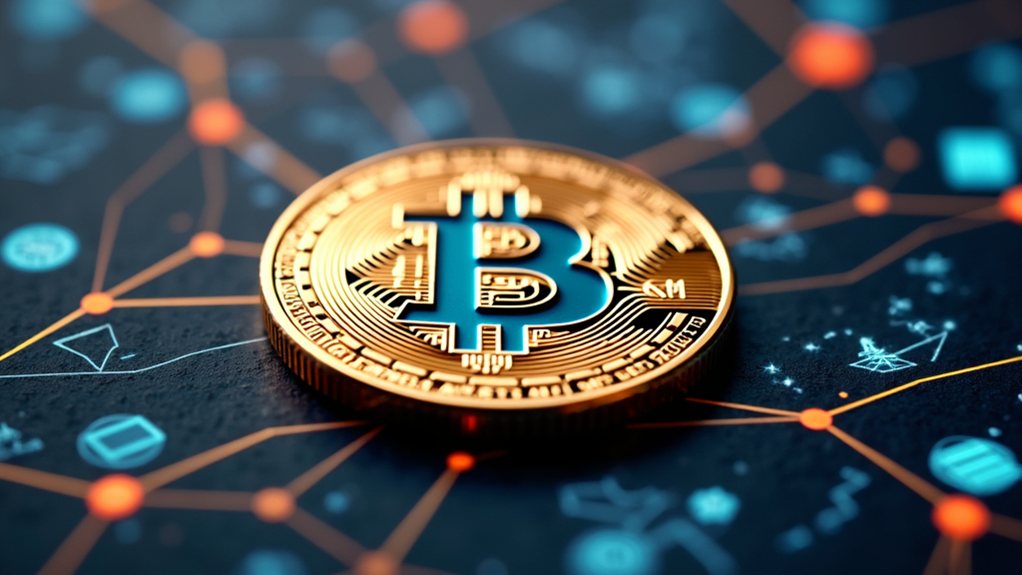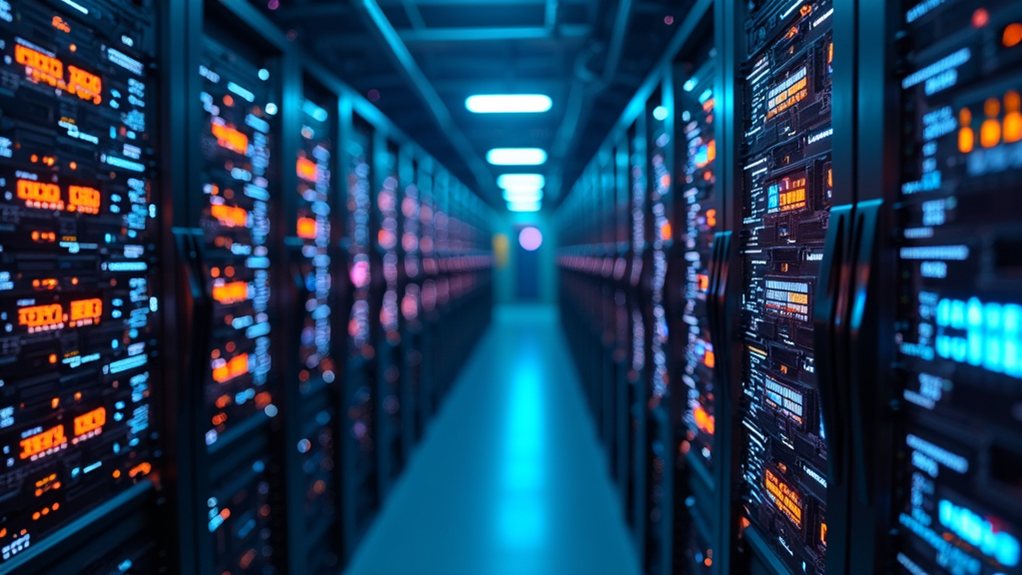NFTs are unique digital assets stored on blockchain that represent artwork and other digital items. They gained popularity in 2021, offering collectors verified authenticity and protection from forgery. Major marketplaces include OpenSea, SuperRare, and Foundation. When evaluating NFTs, collectors should consider the artist's reputation, rarity, quality, and technical aspects. Challenges include price volatility, environmental concerns, and evolving legal frameworks. Further exploration reveals how this technology is reshaping art collection.

As the digital art world continues to evolve, non-fungible tokens (NFTs) have emerged as a revolutionary way for collectors to buy, own, and trade digital creations. These unique digital assets are stored on blockchain technology, which verifies their authenticity and ownership. NFTs first appeared in 2014 but didn't gain mainstream popularity until 2021. They can represent artwork, music, videos, or virtual items that have scarcity in the digital domain.
Art collectors see several benefits in NFTs. They provide access to a growing digital art market and new artists. NFTs guarantee authenticity and provenance, solving a long-standing problem with digital works. They can potentially appreciate in value, though markets remain volatile. The blockchain verification makes digital art less susceptible to forgery compared to traditional physical artwork. Many NFT platforms also enable artists to receive royalties from secondary sales, creating ongoing income for creators. Despite initial market fluctuations, NFTs continue to provide a viable revenue stream for digital artists looking to monetize their work. NFTs are immune to physical damage, eliminating the need for restoration and insurance costs typically associated with traditional art collecting.
NFTs revolutionize digital art ownership, ensuring authenticity while creating potential investment value and ongoing royalties for creators.
The NFT marketplace has expanded rapidly in recent years. OpenSea stands as the largest platform with over 2 million users trading various digital assets. SuperRare offers a more curated experience focusing on single edition artworks. Nifty Gateway, owned by Gemini, hosts drops from prominent artists. Foundation operates on an invite-only model for emerging artists, while Rarible features a community-owned structure with built-in creator royalties.
Evaluating NFT artworks involves several considerations. Collectors often examine the artist's reputation and previous sales history. The rarity and uniqueness of the piece matter greatly in determining value. Quality and aesthetic appeal remain important, just as with traditional art. Technical aspects like file format and smart contract details can affect an NFT's longevity and functionality.
Storage and display options for NFTs continue to evolve. Digital wallets like MetaMask provide secure storage, while hardware wallets offer enhanced security for valuable collections. Physical display options include digital frames and screens. Virtual galleries in metaverse platforms and integration with social media allow for new ways to showcase collections.
The NFT market faces several ongoing challenges. The values can be highly volatile, with prices fluctuating dramatically. Environmental concerns persist regarding the energy usage of certain blockchain networks. Fraud and counterfeit NFTs present risks for collectors. Questions remain about the long-term viability of file formats and hosting solutions for the digital assets.
Legal frameworks around NFTs continue to develop. Copyright laws apply to both NFTs and their underlying artworks. Tax implications vary by jurisdiction, with some countries treating profits as capital gains. As the market matures, regulations will likely evolve to provide more structure and protection for collectors entering this new frontier of digital art ownership.
Frequently Asked Questions
How Do I Verify the Authenticity of an NFT?
Experts verify NFT authenticity through multiple methods.
They check blockchain records for minting details and ownership history. They examine metadata containing creation dates and artist information. Major marketplaces like OpenSea offer verification tools with badges for confirmed creators.
Third-party services such as Verisart provide additional authentication. Collectors often research the artist's reputation and compare the NFT to their established style before purchasing.
Can I Display My NFT Art in Physical Spaces?
NFT art can be displayed in physical spaces through several methods.
Collectors can use digital frames, high-resolution screens, or projectors designed for NFT display at home. Public venues like the Seattle NFT Museum and pop-up exhibitions worldwide now showcase digital art.
Many collectors create dedicated walls with multiple screens and proper lighting. Blockchain-connected displays offer authenticity verification, while QR codes can link viewers to ownership details.
What Happens to My NFT if the Hosting Platform Shuts Down?
If a hosting platform shuts down, an NFT's data could become inaccessible.
The artwork files and metadata might disappear if they're stored on centralized servers. NFTs using decentralized storage like IPFS or Arweave have better protection.
Platform closures like KnownOrigin show this real risk. While the blockchain record of ownership remains, the actual content an NFT points to can vanish without proper backup systems.
Are NFT Investments Tax Deductible for Art Collectors?
NFT investments aren't directly tax deductible for art collectors.
However, collectors may find other tax benefits. Donating appreciated NFTs to qualified charities can create deductions.
NFT-related expenses like storage fees, professional appraisals, and legal services might be deductible in certain situations.
The IRS treats NFTs as property, subjecting them to capital gains tax. Some NFTs may be classified as collectibles, facing a higher 28% long-term capital gains rate.
How Do I Transfer NFT Ownership After Death?
NFT owners can transfer their digital assets after death through proper estate planning. This requires documenting NFT holdings, securing private keys, and naming beneficiaries.
Digital legacy services help manage the shift. Some collectors use multi-signature wallets or "dead man's switch" services for automatic transfers.
Estate attorneys familiar with digital assets can guide the process. Heirs need education on accessing and managing the inherited NFTs.










